Gods of Egypt
The ancient Egyptians were polytheistic, which means they worshiped a wide variety of gods. The exact myths they believed varied as well, depending on time period, location, or even purpose. Certain areas of Egypt were devoted to different aspects of gods, or to local gods of their own creation. There were, however, a set of gods that seemed to be nearly universal in Egyptian belief.
Below is the Ennead of Heliopolis, with some additional familiar faces. The Ennead is a collection of nine gods that were worshiped in the city of Heliopolis, organized into a family tree. These gods are Atum, Shu, Tefnut, Geb, Nut, Osiris, Set, Isis, and Nepthys. These gods, as well as their children and relatives, were credited with a great variety of feats, from the creation of the universe, to the creation of the mummy.
This understanding of the Egyptian gods was not the only one used by its people, but it is often cited by modern historians, and is as good an introduction to the Egyptian gods as any.
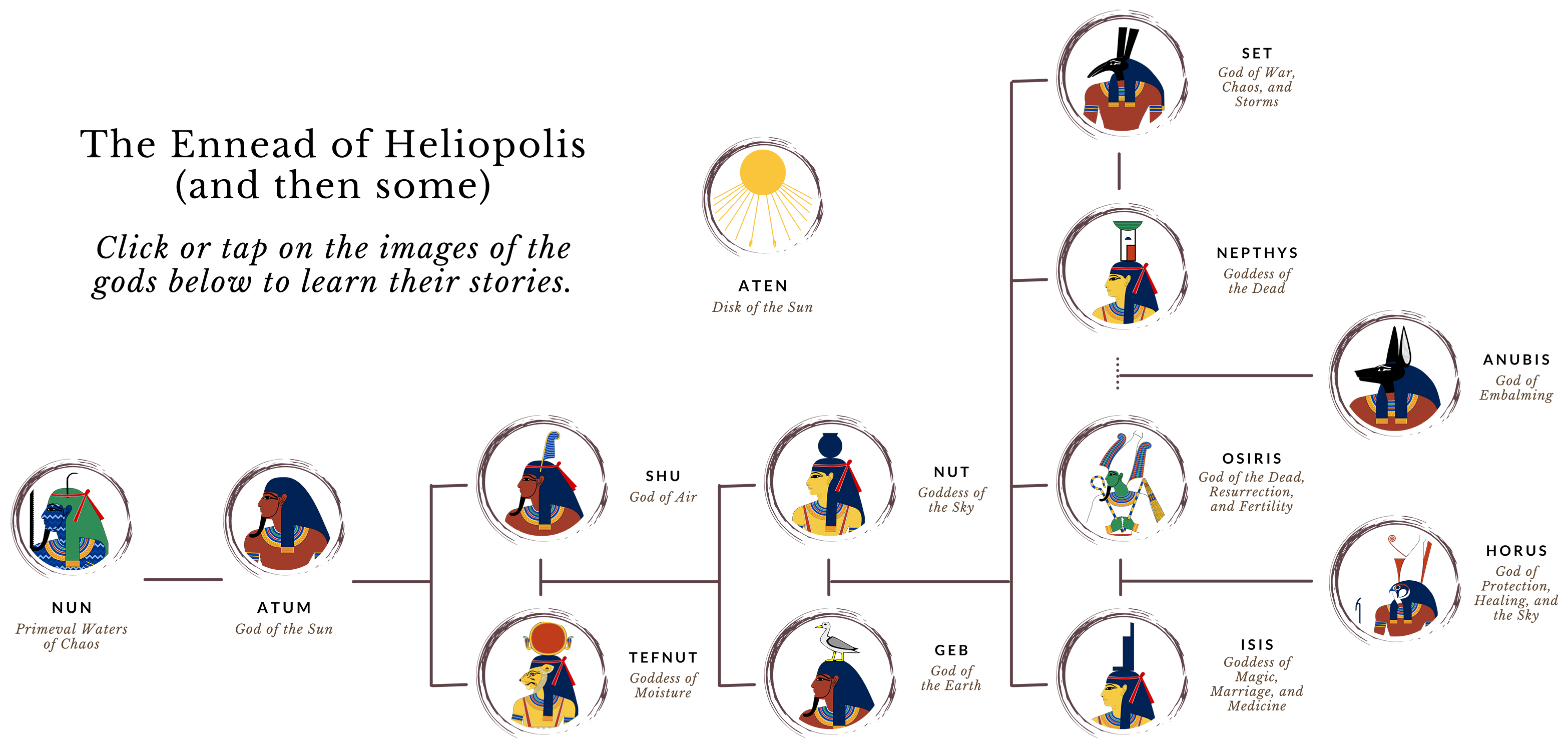
SET
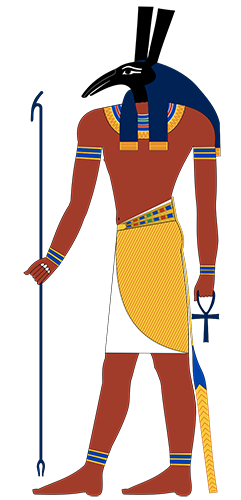
God of War, Chaos, and Storms
Set is a strange deity. The animal most commonly associated with him is referred to as the “Set animal” because it can’t be accurately identified, and the meaning of his name is “instigator of confusion.”
In his earliest appearances, he was friendly, and known as a helper of the dead. But over time, he gained a stronger connection with the desert and the night. In his most famous story, he murders Osiris, who was, at that time, the king of Egypt. His defeat led to the rise of Horus to the throne, and his own banishment to rule over the desert.
He wasn’t entirely evil however. He was known to be one of the defenders of Ra (Atum), fighting off the evil serpent Apephis as Ra pulled the sun through the underworld. In some areas, he was married to Nepthys and honored as a god of love.
Image source:
By Jeff Dahl (talk · contribs) - Own work, CC BY-SA 4.0, https://commons.wikimedia.org/w/index.php?curid=3306905
Nepthys
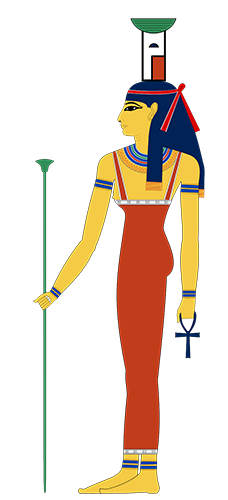 Goddess of the Dead
Goddess of the Dead
As the last to be born on the demon days, Nepthys is sometimes thought to be the mirror of Isis, in the same way Set is a mirror of Osiris. She was known to be a magician and a healer, just as Isis was, but she was married to Set, and she tended to be related to more negative aspects of Egyptian daily life.
Before his death, she seduced Osiris, tricking him into conceiving their son, Anubis. This probably didn’t put her in Isis’ good graces, but later, after Set killed Osiris, Nepthys helped Isis to recover the lost pieces of her husband and used her magic to keep Isis and Horus hidden.
In tomb reliefs, she and Isis are often depicted mourning together, sometimes called the “Weeping Sisters.” She and Isis stand at the head and foot of the coffin to protect it. In the Pyramid Texts, they both stand behind Osiris during the weighing of the hearts ceremony.
Image source:
By Jeff Dahl (talk · contribs) - Own work, CC BY-SA 4.0
https://commons.wikimedia.org/w/index.php?curid=3306905
Anubis
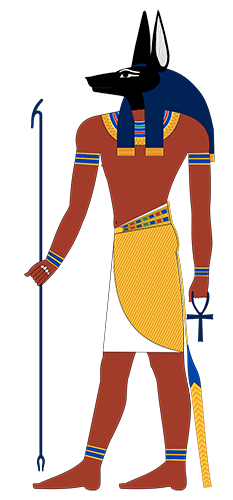 God of Embalming
God of Embalming
The illegitimate son of Osiris and Nepthys, Anubis has become one of the most recognizable gods of ancient Egypt. He is depicted most commonly as a man with the head of a jackal, and he is seen on many tombs, or in burial rites. He is, however, not the god of the dead, but rather the god of embalming.
When Osiris died, Anubis invented the process of mummification to aid in his father’s resurrection, earning him the title of “Lord of the Mummy Wrappings.” Afterwards, he helped all Egyptians in their journey after death.
His Egyptian name, Anpu, means “Opener of the Way”, and is in reference to his role as a guide to the dead through the afterlife. He is said to lead souls to the room of judgment, where their heart will be weighed against the feather of Ma’at.
Image source:
By Jeff Dahl - Own work, CC BY-SA 4.0
https://commons.wikimedia.org/w/index.php?curid=3257647
Osiris
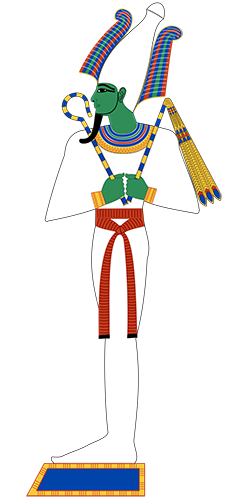 God of the Dead, Resurrection, and Fertility
God of the Dead, Resurrection, and Fertility
It was Osiris who ruled over the land of Egypt. He taught early humans the ways of agriculture and civilization, and served as pharaoh.
Jealous, his brother Set hatched a plot to kill him. He invited Osiris to a large feast and presented him with a golden coffin, saying that whoever fit into the coffin could keep it. Several of the guests—Set’s conspirators—attempted to fit themselves into the coffin, but they knew it would never fit them. It had been specifically crafted to fit the king.
When it was his turn, Osiris laid down inside the coffin. Before he could get up, Set and his conspirators closed the coffin and nailed it shut. His body was then shipped down the Nile, and his soul was sent to become the ruler of the Underworld.
Isis, the wife of Osiris, searched far and wide for the coffin, only to be thwarted by Set once again. He found the body and tore it apart before Isis could resurrect her husband, and spread the pieces all over Egypt. Undeterred, Isis recovered the pieces and wraps them together, performing proper burial rites and mummification. Before he took his throne in the underworld, Osiris and Isis conceived Horus.
Because of this saga, depictions of Osiris tend to show him in mummy wrappings, presiding over the Underworld.
Image source:
By Jeff Dahl - Own work, CC BY-SA 4.0
https://commons.wikimedia.org/w/index.php?curid=3248602
Horus
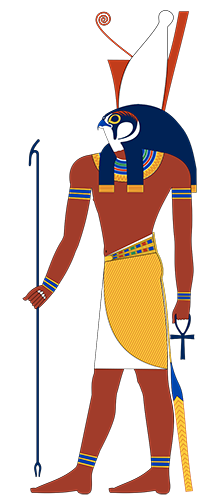 God of protection, healing, and the sky
God of protection, healing, and the sky
After the death of Osiris, there was a power vacuum in Egypt. Set still sought the throne, but Horus, as the son of the late king, had a stronger claim. In some stories, Horus and Set settle this dispute in a series of courtroom trials, overseen by a variety of gods.
The most popular story, however, was much more violent.
Set made constant threats on Horus’ life, going back into his childhood. Horus and his mother, Isis, had to be hidden from him until the boy came of age. Only then could he fight his uncle. When he did, Horus emerged victorious, ascending to the throne, but losing one of his eyes. The Eye of Horus, or wadjet, became a powerful protective symbol in Egyptian theology.
Horus firmly established Osiris as the ruler of the underworld, and himself as pharaoh. At times, Horus is referred to as the “Unifier of Two Lands”, which likely refers to the unification of Upper and Lower Egypt that began dynastic rule. He is often depicted as a man with the head of a hawk, wearing the double crown of Upper and Lower Egypt.
Image source:
By Jeff Dahl - Own work, CC BY-SA 4.0
https://commons.wikimedia.org/w/index.php?curid=3280569
Isis
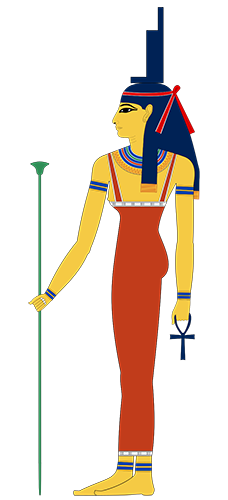 Goddess of Magic, Marriage, and Medicine
Goddess of Magic, Marriage, and Medicine
As one of the most beloved of the gods, Isis was considered the Mistress of Magic, as well as the wife of Osiris and the mother of Horus. At times, she was referred to as Weret-Hekau, meaning “Great of Magic”, and also Mut-netjer, “the Mother of the Gods.” Her Egyptian name, Aset, meaning “seat”, seems to speak to her role as the wife of Osiris; he held power over Egypt, and she was his support, both literally and metaphorically. As Egyptologist Christina Riggs put it, Isis was “his place in the universe.”
Not only did Isis use her magic to resurrect Osiris, but she was also the one to learn the secret name of Ra—which was not an easy thing to do.
As the story goes, Isis was in need of stronger magic, so she approached Atum, who was in his elderly form, Ra. She collects some of his drool and mixes it with clay to form a snake. She brings the snake to life and places it in the path of Ra. When it bites him, Ra seems sure to die. But then Isis steps in. She says she’ll heal him, but in order to do so, she needs to know his secret name.
In Egyptian theology, a name is a powerful thing—the gods themselves had several. A secret name, if shared, was like handing over a piece of your soul. By learning Ra’s secret name, Isis would gain a portion of Ra’s power, making her the most powerful magician in the universe.
Ra refused to share his name.
Until, of course, the venom spread. By the time Ra relented, it had stricken him blind. The knowledge of Ra’s secret name passed from him into Isis in what Egyptologist Christina Riggs called “an ancient Egyptian mind-meld.” She heals Ra with her newfound power.
After this point, she is unmatched in magical ability.
Image source:
By Jeff Dahl - Own work, CC BY-SA 4.0
https://commons.wikimedia.org/w/index.php?curid=3252750
Aten

The Disk of the Sun
In the early New Kingdom, a pharaoh named Amenhotep IV decided to change the state religion. He insisted that Egyptians abandon polytheism and worship Aten instead.
Aten was a lesser-known deity, possibly a form of Ra. He was, in essence, the disk of the sun. In the time of Amenhotep IV, he was separated from any other forms of Ra and worshiped alone in what many scholars consider to be the world’s first monotheistic religion. Amenhotep IV changed his royal name to Akhenaten. After his death, the regular polytheistic religion was reinstated.
Akhenaten’s son was originally named Tutankhaten to honor Aten. He is perhaps better known by the name he earned after his father’s death: Tutankamun, a.k.a. King Tut.
Image source:
By AtonX - Image:Aten.JPG, CC BY 2.5
https://commons.wikimedia.org/w/index.php?curid=1527659
Nut and Geb
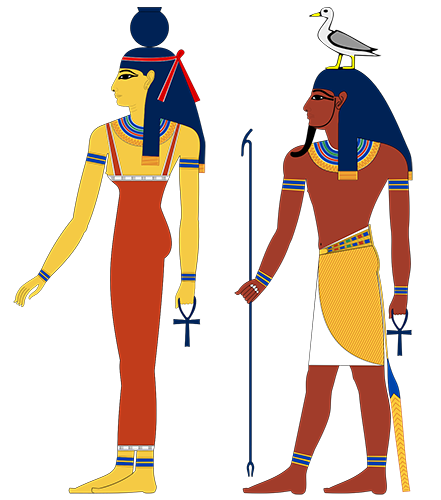 Goddess of the Sky and God of the Earth
Goddess of the Sky and God of the Earth
As the children of Shu and Tefnut, Nut and Geb ruled over the sky and the earth respectively. After being cursed by Ra, they were held apart by Shu, and Nut was unable to give birth on any date of the Egyptian calendar.
At this time, the Egyptian calendar only contained 360 days, but Thoth (god of learning, writing, and time) played a game of dice against Aah (god of the moon) to earn an additional five days. On those days, Nut was no longer bound by Ra’s curse, and could give birth to five children—one a day.
The first day saw the birth of Osiris, followed by Horus the Elder (whose place in mythology is often merged with Horus the Younger, if entirely disregarded), Seth, Isis, and finally, on the last day, Nepthys.
Later, these five days fell in between the last and first months of the Egyptian calendar. They are sometimes referred to as the demon days, because minor gods and spirits were thought to run rampant during this time.
Image sources:
By Daniel Toye - Own work, CC BY-SA 3.0
https://commons.wikimedia.org/w/index.php?curid=24970895
By A. Parrot - Own work, CC BY-SA 3.0
https://commons.wikimedia.org/w/index.php?curid=24457191
Shu and Tefnut
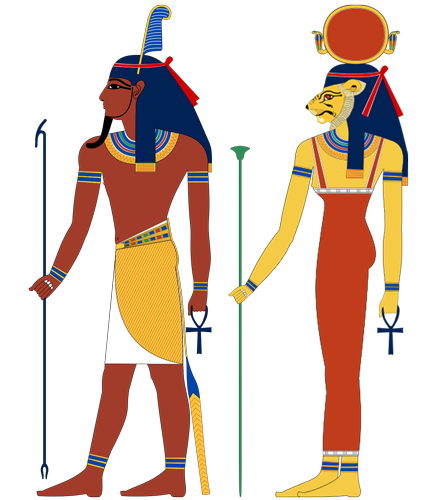 God of Air and Goddess of Moisture
God of Air and Goddess of Moisture
To help him build the universe, Atum created Shu and Tefnut by spitting, sneezing, or vomiting them into existence. Shu, who was usually depicted as a man with a feather on his head, was associated with dry air, peace, and order (Ma’at) over chaos. His wife Tefnut, on the other hand, represented moist air, dew, and rain. Her typical image, of a woman with the head of a lioness, hinted at her more wrathful nature. Together, they are the parents of Nut and Geb.
In one story, Atum loses Shu and Tefnut, and, upon finding them, he weeps. His tears became the first human beings.
Image sources:
By Jeff Dahl - Own work, CC BY-SA 4.0
https://commons.wikimedia.org/w/index.php?curid=3339075
By A8takashi - Own work, CC BY-SA 4.0
https://commons.wikimedia.org/w/index.php?curid=50566772
Atum
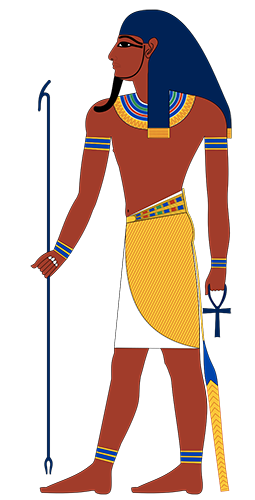 God of the Sun
God of the Sun
After rising from Nun and creating several other gods, Atum’s chief task was to sail the sun across the sky in the daytime, and then, at night, sail it through the duat, or the underworld. In the course of this journey, he had to fight the serpent of chaos, Apep. Only by defeating Apep each night could Atum’s solar bark (boat) rise in the sky, carrying the sun with it.
Not only did Atum have many identities—he was Khepera when the sun rose, Ra in the afternoon, and Atum when the sun set—but he also became fused with many gods, such as Amun, Horus, and Osiris. These fusions tended to depend on the politics of local religious cults, the location of Egypt’s capital, and of course, time.
In general, Atum was viewed as a creator god. In some stories, humanity itself was born from his tears and sweat. He was the father of multiple gods, including Bast (cat goddess, associated with vengeance and protection), Sekhmet (warrior goddess, associated with Hathor), Shu, and Tefnut. Ma’at, another of his children, is the goddess of order and justice; as he was her father, Atum was thought to be the ultimate authority over Egypt, and was sometimes considered to be the original pharaoh.
Image source:
By Jeff Dahl - Own work, CC BY-SA 4.0
https://commons.wikimedia.org/w/index.php?curid=3304676
Nun
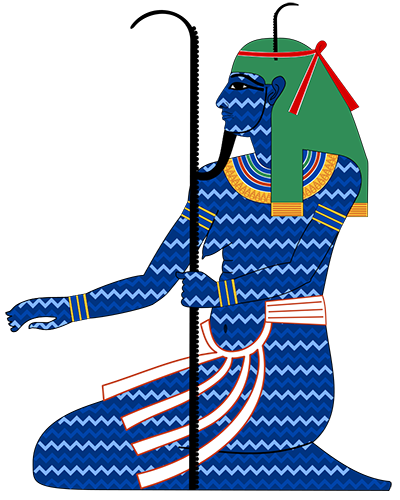 Primeval Waters of Chaos
Primeval Waters of Chaos
Before there was Egypt, before there was humanity, and before there were gods, there was Nun. Described as a watery waste with no light or darkness, Nun is the chaotic nothingness from which the first god, Atum, emerged. Needing a place to rest, Atum raised the first mound of earth out of the water. Often, this act is related to the Nile’s annual inundation, when the river floods, then recedes, leaving behind fertile, farmable land.
Atum, and the gods that came after him, would go on to create the rest of the universe, around which the waters of Nun still churned. So, every day, when the sun would rise, it was said to be rising from the waters of Nun, reenacting that original act of creation.
Image source:
By Jeff Dahl - Own work, CC BY-SA 4.0
https://commons.wikimedia.org/w/index.php?curid=3375043


